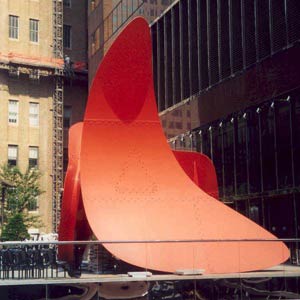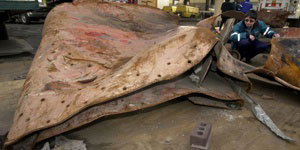
 Sculpture News at SculptSite.com
Sculpture News at SculptSite.com
9/11 Art & Sculpture Losses |
| New York Post By BILL SANDERSON More than $100M in art lost in 9/11 attacksIt's the lost art of 9/11. "Bent Propeller" was 25 feet tall, steel forged into elegant curves painted red by its sculptor, famed modernist Alexander Calder. It arrived at the World Trade Center in 1971, part of a Port Authority plan to humanize the space around the immense Twin Towers with public art. Over the next 30 years, Bent Propeller was always displayed outside, where anyone could see it. On Sept. 11 it was on a pedestrian platform over Vesey Street that linked 7 World Trade Center to the rest of the complex. Calder's grandson, Alexander Rower, watched the terror attacks from his apartment in Chelsea. "I just got off the phone with my brother - we were supposed to go meet a lawyer. He called me right back and said, 'A missile just flew over my head and smashed into the Trade Center.'" He knew Bent Propeller was gone - but decided not to think about it in the days that followed as he pitched in, ferrying supplies to Ground Zero workers in his pickup truck. After it was clear no one would be found alive in the rubble, Rower printed brochures with a picture of Bent Propeller. "Please Help Recover and Preserve Famous AMERICAN SCULPTURE," it said. Soon he got a phone call. "I was there when they pulled some of the parts out of the ash," Rower said. "This was October 11. The steel was still red hot, which was shocking to me. The heat, the intensity of that devastation was so incredible." About 30 percent of the sculpture survived. Today, the remains - four big pieces of steel, bent, but not as Calder intended - lie inside a tent in the Kennedy Airport hangar where the Port Authority stores 9/11 artifacts. The tent is dehumidified, so the metal won't rust further. Some of the paint remains, though it's a lot darker than the original red. More than $100 million worth of art was destroyed on 9/11. An extensive collection of Rodin sculptures and drawings owned by brokerage firm Cantor Fitzgerald was lost. Works by Picasso, Roy Lichtenstein and Le Corbusier that belonged to companies with offices or businesses in the buildings were reduced to ash. In the lobby of the south tower - from where tourists headed to the observation deck - was a tapestry by Joan Miró, another famed 20th-century modern artist and a Calder friend. It is gone. For months after workers found Bent Propeller's remains, Rower talked of turning them into some new piece of art. He eventually gave up on the idea. "It can not be refashioned... It's a dead issue," he said. Rower likes what he sees going on downtown. "I like the geometry of the tower that's going up - the angularity of it. It's like a crystal growing," he said. The hulking metal fragments of Bent Propeller are expected to end up nearby, in the Sept. 11 memorial museum. |
 Kudos to Bill Sanderson of the New York Post for his skill in telling an important story. Not much else can be said, only felt... |
 |
| The Alexander Calder sculpture, 'Bent Propeller,' before the attacks. |
 |
| Lucy Foster, the Port Authority manager whose duties include upkeep of its public art, looks over what remains of the Alexander Calder sculpture, 'Bent Propeller,' in 2002. |
More Sculpture News ....
Submit your SCULPTURE NEWS.
It's easy, just send us an e-mail
(click on Submit News in the left menu) with your pertinent information along with images, we'll take care of the rest. Sculpture makes our world a much better place in so many ways!
SculptSite.com, along with Sculptors and their creative genius all helping to bring the beauty and message of Sculpture to a hurried world.

